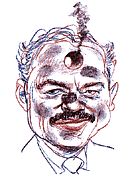
Bob Barr (R-Geor.) has never met a gun he didn’t like. That and his power position in the House earn him high marks from the National Rifle Association. In 1993-94, the NRA spent more than $4.7 million to help the Republicans take over Congress. And no other member of the House owes as much to the gun group as Barr. The NRA hand-picked him for the primary and then, in a move motivated by revenge, helped him defeat veteran Democrat Buddy Darden in November.
Early in 1994, when Barr began his run for Congress, the NRA provided his campaign with critical support and worked closely with him to get out the vote, knowing that with the low turnout expected for the off-year primary, it could make the difference. The Georgia Gun Owners’ PAC, which received funds from the NRA, also threw its support behind Barr and provided $5,000 in crucial money for the primary race. Barr won handily.
The NRA put $4,950 more into Barr’s campaign coffers when he moved on to face Darden in the general election. During his 11 previous years in Congress, Darden had enjoyed the NRA’s backing. But not this time. Darden, annoyed at the organization’s backroom maneuvering, had voted for the president’s 1994 crime bill, which included the assault weapons ban. “The NRA decided to make an example of Buddy Darden, as a warning to others,” says a leading Democratic strategist in Georgia. (A similar scenario played out in Texas, where Steve Stockman defeated Rep. Jack Brooks, a longtime NRA friend.)
The NRA backed Barr’s campaign even though he seemed vulnerable on the “character” issue. Married three times and embroiled in a messy court battle with his second wife over his failure to pay child support, Barr had been photographed in 1992 licking whipped cream off two buxom young women’s chests. And this from the man who would later sponsor the Defense of Marriage Act.
But with the support of a far-right coalition including elements of the NRA, the John Birch Society, the Christian Coalition, and the National Right to Life Committee, Barr won the election with 52 percent of the vote. The payoff for the NRA came in early 1995, when Newt Gingrich appointed a task force to examine firearms legislation. At the NRA’s urging, the speaker named Barr to head the task force.
Barr’s agenda is unabashedly pro-NRA. He proposes abolishing the Bureau of Alcohol, Tobacco, and Firearms and revoking the Brady Bill that requires waiting periods for the purchase of handguns. This summer he stumped for a bill that eliminated funding for research at the Centers for Disease Control on gun-related fatalities. “[The CDC has] not eradicated disease,” said Barr. “They have work left to do.”
Most importantly, he engineered the March 22 House vote repealing the ban on semiautomatic assault weapons. “It was Bob Barr’s job to get it done, and he did,” says Neal Knox, the NRA’s first vice president.
Three times, Barr charged up the Hill to push the repeal vote. He managed to get a vote scheduled for May 1995, but it was taken off the agenda after the Oklahoma City bombing. Last fall, Barr organized more than 100 of his colleagues, Democrats as well as Republicans, to repeal the ban. But his effort got lost in the furor over the 1996 budget.
Finally, in early March this year, Barr had lined up enough House members to force a vote. With only two hours scheduled for debate, and no committee hearings, the bill passed 239-173. Sixty-eight out of 86 House freshmen voted to repeal the ban.
Tanya Metaksa, executive director of the NRA’s political arm, told Mother Jones, “It wasn’t the task force that got the vote scheduled. It was Bob. He convinced his colleagues in the Republican Caucus to do it.”















